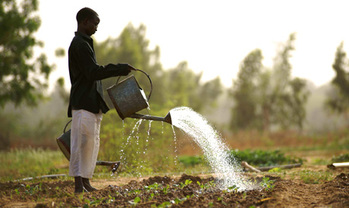Soil Protection and Rehabilitation of Degraded Soil for Food Security (ProSoil)
Project description
Title: Soil protection and rehabilitation for food security
Commissioned by: German Federal Ministry for Economic Cooperation and Development (BMZ)
Co-funded by: European Union (EU), Bill & Melinda Gates Foundation (BMGF)
Country: Supraregional: Benin, Burkina Faso, Ethiopia, India, Kenya, Madagascar, Tunisia
Lead executing agency: Depends on the country; usually the Ministry of Agriculture.
Overall term: 2014 to 2027

Context
It takes millennia for soils to form. At the same time, this raw material is finite. Overexploitation can result in nutrient depletion and soil erosion, and even to complete destruction. Climate change exacerbates these effects, for example through periods of drought or more frequent heavy rainfall. Every year, some ten million hectares of soil are destroyed in this way worldwide, which corresponds to an area around one third of the size of Germany. The amount of land available for agricultural use is shrinking, while at the same time the number of people that require food is rising.
These developments have immediate consequences, in particular for smallholders in developing countries, because soil degradation has direct impacts not only on their income, but also on their food situation. A decade ago, a family might have been able to cultivate three hectares of cassava, but today the usable area will already have shrunk by half – and with it the size and quality of the harvest.
Soil is the second-largest carbon store on Earth after the oceans. Together, they contain more CO2 than all of the forests and the atmosphere together. Soil degradation, however, releases large quantities of CO2 from the soil. Every year, some 24 billion tonnes of soil are lost simply through erosion, for example by wind and weather, or water. This has massive consequences for agriculture and the climate. While carbon as an organic material in the soil is vital to the latter’s fertility, in the form of CO2 in the atmosphere, it exacerbates global warming.
Best practices for sustainable land use are well known and are economically viable. Despite this, they are applied only to a limited area. Disseminating these practices is difficult. In many countries, soil protection does not receive the political attention it needs. The responsible institutions often fail to tackle the issue in an appropriate manner. As a result, there is a lack of incentives, such as secure land rights for agricultural enterprises, to ensure that they use soils in a resource-friendly and sustainable way. Smallholders in particular frequently lack the know-how to apply soil-friendly farming methods to their land, or the money for initial investments.
Objective
Approaches to promoting lasting soil protection and rehabilitation are implemented and shared in selected partner countries.
Approach
The programme works in coordination with the relevant ministries in the partner countries. It promotes sustainable land use, based in particular on the involvement of the affected smallholders. These are the primary target group and receive advice on agroecological practices. These practices help in building up organic matter (humus), as well as in enhancing fertility and the soil’s capacity to absorb water. The immediate advantage is rising yields. This improves the food situation of smallholders and opens up new sources of income.
Besides small farming businesses and the relevant state institutions, other players from the academic and research communities, the private sector and civil society, as well as from other state bodies, are involved in these measures.
The programme advises the partner governments on how to improve the political and institutional framework. The governments need to create incentives for farmers to use land in a more sustainable way. To support the sharing of knowledge and experience, the programme organises national and international forums where the relevant stakeholders can meet.
The contributions of soil protection to climate change adaptation and mitigation are measured using a climate monitoring system. This is a first step towards promoting soil protection through climate finance.
Results
- Since its inception, the programme has protected or rehabilitated 565,888 hectares of land. An area almost 10.5 times the size of the Lake of Constance has thus been returned to productive agriculture.
- The yields achieved by smallholders on this land have been 38 per cent higher on average. This directly improves the food situation of 1.3 million people.